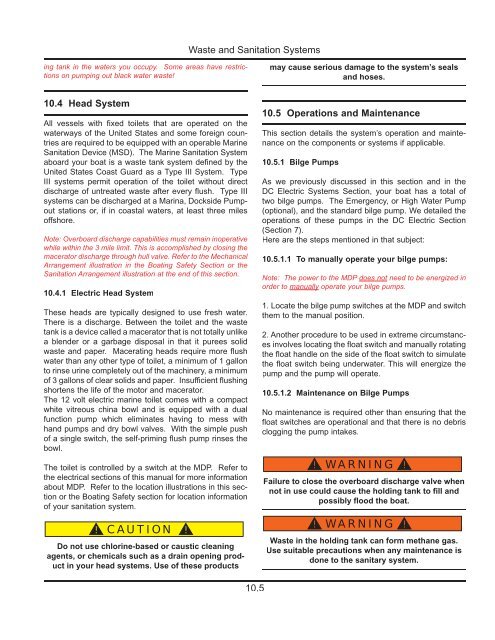36e Operator's Manual 2011.pdf - Marlow-Hunter, LLC
36e Operator's Manual 2011.pdf - Marlow-Hunter, LLC
36e Operator's Manual 2011.pdf - Marlow-Hunter, LLC
Create successful ePaper yourself
Turn your PDF publications into a flip-book with our unique Google optimized e-Paper software.
Waste and Sanitation Systems<br />
ing tank in the waters you occupy. Some areas have restrictions<br />
on pumping out black water waste!<br />
may cause serious damage to the system’s seals<br />
and hoses.<br />
10.4 Head System<br />
All vessels with fixed toilets that are operated on the<br />
waterways of the United States and some foreign countries<br />
are required to be equipped with an operable Marine<br />
Sanitation Device (MSD). The Marine Sanitation System<br />
aboard your boat is a waste tank system defined by the<br />
United States Coast Guard as a Type III System. Type<br />
III systems permit operation of the toilet without direct<br />
discharge of untreated waste after every flush. Type III<br />
systems can be discharged at a Marina, Dockside Pumpout<br />
stations or, if in coastal waters, at least three miles<br />
offshore.<br />
Note: Overboard discharge capabilities must remain inoperative<br />
while within the 3 mile limit. This is accomplished by closing the<br />
macerator discharge through hull valve. Refer to the Mechanical<br />
Arrangement illustration in the Boating Safety Section or the<br />
Sanitation Arrangement illustration at the end of this section.<br />
10.4.1 Electric Head System<br />
These heads are typically designed to use fresh water.<br />
There is a discharge. Between the toilet and the waste<br />
tank is a device called a macerator that is not totally unlike<br />
a blender or a garbage disposal in that it purees solid<br />
waste and paper. Macerating heads require more flush<br />
water than any other type of toilet, a minimum of 1 gallon<br />
to rinse urine completely out of the machinery, a minimum<br />
of 3 gallons of clear solids and paper. Insufficient flushing<br />
shortens the life of the motor and macerator.<br />
The 12 volt electric marine toilet comes with a compact<br />
white vitreous china bowl and is equipped with a dual<br />
function pump which eliminates having to mess with<br />
hand pumps and dry bowl valves. With the simple push<br />
of a single switch, the self-priming flush pump rinses the<br />
bowl.<br />
The toilet is controlled by a switch at the MDP. Refer to<br />
the electrical sections of this manual for more information<br />
about MDP. Refer to the location illustrations in this section<br />
or the Boating Safety section for location information<br />
of your sanitation system.<br />
! CAUTION !<br />
Do not use chlorine-based or caustic cleaning<br />
agents, or chemicals such as a drain opening product<br />
in your head systems. Use of these products<br />
10.5 Operations and Maintenance<br />
This section details the system’s operation and maintenance<br />
on the components or systems if applicable.<br />
10.5.1 Bilge Pumps<br />
As we previously discussed in this section and in the<br />
DC Electric Systems Section, your boat has a total of<br />
two bilge pumps. The Emergency, or High Water Pump<br />
(optional), and the standard bilge pump. We detailed the<br />
operations of these pumps in the DC Electric Section<br />
(Section 7).<br />
Here are the steps mentioned in that subject:<br />
10.5.1.1 To manually operate your bilge pumps:<br />
Note: The power to the MDP does not need to be energized in<br />
order to manually operate your bilge pumps.<br />
1. Locate the bilge pump switches at the MDP and switch<br />
them to the manual position.<br />
2. Another procedure to be used in extreme circumstances<br />
involves locating the float switch and manually rotating<br />
the float handle on the side of the float switch to simulate<br />
the float switch being underwater. This will energize the<br />
pump and the pump will operate.<br />
10.5.1.2 Maintenance on Bilge Pumps<br />
No maintenance is required other than ensuring that the<br />
float switches are operational and that there is no debris<br />
clogging the pump intakes.<br />
! WARNING !<br />
Failure to close the overboard discharge valve when<br />
not in use could cause the holding tank to fill and<br />
possibly flood the boat.<br />
! WARNING !<br />
Waste in the holding tank can form methane gas.<br />
Use suitable precautions when any maintenance is<br />
done to the sanitary system.<br />
10.5

















